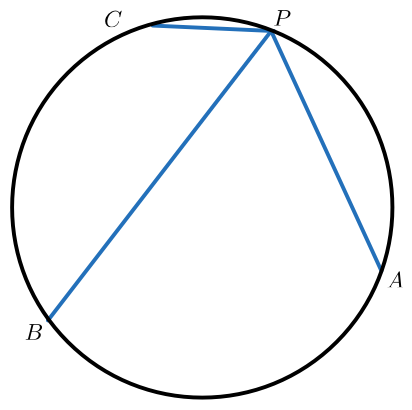Three Chords & The Truth
 Segments
P
A
,
P
B
, and
P
C
are all chords of the same circle,
Γ
, such that
P
A
=
5
,
P
B
=
8
, and
P
C
=
3
. In addition,
∠
A
P
B
≅
∠
B
P
C
.
The area of
Γ
can be written as
b
a
π
, where
a
and
b
are positive, coprime integers. Find
a
+
b
.
Segments
P
A
,
P
B
, and
P
C
are all chords of the same circle,
Γ
, such that
P
A
=
5
,
P
B
=
8
, and
P
C
=
3
. In addition,
∠
A
P
B
≅
∠
B
P
C
.
The area of
Γ
can be written as
b
a
π
, where
a
and
b
are positive, coprime integers. Find
a
+
b
.
The answer is 52.
This section requires Javascript.
You are seeing this because something didn't load right. We suggest you, (a) try
refreshing the page, (b) enabling javascript if it is disabled on your browser and,
finally, (c)
loading the
non-javascript version of this page
. We're sorry about the hassle.
3 solutions
Discussions for this problem are now closed
The question asks to find
R
2
where
R
is the radius.
 image
image
In the figure, ∠ O C P = ∠ O P C = θ and ∠ O P A = ∠ O A P = α .
Now,
2 R c o s ( θ ) = 3
2 R c o s ( α ) = 5
2 R c o s ( 2 θ − α ) = 8
So,
2 c o s 2 ( 2 θ − α ) − 1 = c o s ( θ − α ) = 2 ( R 4 ) 2 − 1
⟹ c o s ( θ ) c o s ( α ) + s i n ( θ ) s i n ( α ) = R 2 3 2 − 1
⟹ 2 R 3 2 R 5 + 2 R 4 R 2 − 9 2 R 4 R 2 − 2 5 = R 2 3 2 − 1
⟹ ( 4 R 2 − 9 ) ( 4 R 2 − 2 5 ) = 1 1 3 − 4 R 2 ⟹ R 2 = 7 6 8 1 2 5 4 4 = 3 4 9
⟹ π R 2 = π 3 4 9
Hence, 4 9 + 3 = 5 2
WOW!
Since angle APB = angle BPC, line AB = line BC. Let angle APB = x. Using cosine rule on triangle PAB and PBC, we get AB^2 = 73 - 48cosx = 89 - 80cosx. Solving it, we get x = 60 degrees and AB = 7. Using the extended sine rule on triangle PAB, we get 7/sin(60) = 2R where R is the circumradius of triangle PAB. Finally, we get a/b = R^2 = 49/3. a+b = 52.
Wow.
A neat solution
Correction: 7/cos(60) = 2R is incorrect. It should be 7/sin(60 degrees) = 2R
Thanks for the correction! :) My bad...
∠ A P B = ∠ B P C ⇒ A B = B C ⇒ A B = B C
Let, A B = B C = x .
Then, by Ptolemy's Theorem,
P A ⋅ C B + P C ⋅ A B = P B ⋅ A C
⇒ 5 x + 3 x = 8 A C
⇒ 8 x = 8 A C
⇒ x = A C
∴ A B = B C = A C
So, △ A B C is equilateral.
∴ ∠ A P B = ∠ A C B = 6 0 ∘
Now, applying Cosine-Rule to △ A P B , we get,
A B 2 = P B 2 + P A 2 − 2 ⋅ P B ⋅ P A ⋅ cos ∠ A P B
= 8 2 + 5 2 − 2 . 8 . 5 cos 6 0 ∘
= 4 9
∴ A B = 7 .
Now, A B = 2 R ⋅ sin 6 0 ∘ ⇒ R = 3 7
∴ Area of Γ = π R 2 = π ⋅ ( 3 7 ) 2 = 3 4 9 π
∴ a + b = 4 9 + 3 = 5 2